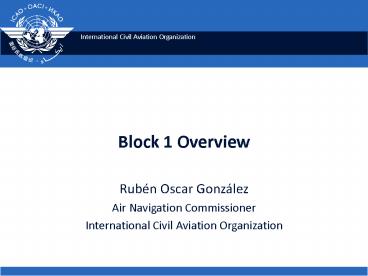Block 1 Overview - PowerPoint PPT Presentation
Title:
Block 1 Overview
Description:
Block 1 Overview Rub n Oscar Gonz lez Air Navigation Commissioner International Civil Aviation Organization Now let s look at an example from Globally ... – PowerPoint PPT presentation
Number of Views:64
Avg rating:3.0/5.0
Title: Block 1 Overview
1
Block 1 Overview
- Rubén Oscar González
- Air Navigation Commissioner
- International Civil Aviation Organization
2
Block 1 Overview
Performance Improvement Areas
Block 0 (2013)
Airport Operations
Globally Interoperable Systems and Data
Optimum Capacity and Flexible Flights
Efficient Flight Path
3
Block 1 PIAs and Modules
- 4 Main Performance improvement areas
- Airport operations (6 modules)
- Globally interoperable systems data (4 modules)
- Optimum capacity flexible flights (4 modules)
- Efficient flight path (3 modules)
- Block 1 will serve as the enabler and foundation
for the envisioned future aviation systems.
4
Block Maturity Lifecycle
Planning Decisions
B3
based on business case and validation results as
developed during the previous phase
B2
B1
2018
SIMPLIFIED LIFECYCLE
V0
Identification of Needs
V1
V1
Concept Definition
B0
Feasibility
V2
V2
RD
-
Pre-Industrial Development and Integration
V3
V3
Industrialisation
V4
V4
Implementation
V5
Deployment
V5
Decision
V6
Operations
V6
Decision
Operations
Decommissioning
V7
V7
Decision
Decision
IOC
Initial Operational Capability
Standardisation activities
Block 1 will see critical ANSP capabilities
synchronized.
5
Block 1 Across the Phases of Flight
Information
B1-30 - Service Improvement through Integration
of all Digital ATM Information
B1-105 Enhanced Operational Decisions through
Integrated Meteorological Information (Planning
Near-term Service)
B1-31 - Performance Improvement through the
application of System Wide Information Management
(SWIM)
Network
B1-35 - Enhanced Flow Performance through Network
Operational Planning
B1-102 Ground-Based Safety Nets on Approach
B1-40 - Improved Traffic Synchronisation and
Initial Trajectory-Based Operation
ToD
ToC
B1-05 - Improved Flexibility Efficiency in
Descent Profiles (OPDs)
B1-15 - Improved Airport Operations through
Departure, Surface and Arrival Management
B1-85 - Increased Capacity Efficiency through
Interval Management
B1-10 - Improved Operations through Free Routing
B1-65 - Optimised Airport Accessibility
CTA
B1-90 - Initial Integration of Remotely Piloted
Aircraft (RPA) Systems into Non-segregated
Airspace
B1-25 - Increased Interoperability, Efficiency
Capacity though FF-ICE/1 application before
Departure
B1-80 - Optimised Airport Operations through
A-CDM Total Airport Management
B1-70 - Increased Runway Throughput through
Dynamic Wake Turbulence Separation
B1-81 - Remotely Operated Aerodrome Control
Management
B1-75 - Enhanced Safety Efficiency of Surface
Operations
Infrastructure
6
B1-15 - Improved Approach Departure
Management through Integration
B1-15 - Improved Airport Operations through
Departure, Surface and Arrival Management
B0-15
B1-15
7
B1-70 Increased Runway Throughput through
Dynamic Wake Turbulence Separation
B1-70 - Increased Runway Throughput through
Dynamic Wake Turbulence Separation
B1-70
B2-70
8
B1-70 Increased Runway Throughput through
Dynamic Wake Turbulence Separation
- Wake vortex separation can be reduced under
certain crosswind conditions. - This upgrade requires
- Tactical Wind Prediction and Monitor function
(for next departure) - Strategic Weather function (for planning horizon)
- Stability of operation to ensure
usability/reliability
9
B1-30 Service Improvement through Integration
of all Digital ATM Information
B1-30 - Service Improvement through Integration
of all Digital ATM Information
B1-80
B0-30
B1-30
B2-31
B1-31
B2-35
10
B1-105 - Enhanced Operational Decisions
through Integrated Meteorological Information
(Planning and Near-Term Service)
B1-105 - Enhanced Operational Decisions
through Integrated Meteorological Information
(Planning and Near-term Service)
B2-31
B1-105
B3-105
11
B1-05 - Improved Flexibility Efficiency in
Descent Profiles (OPDs)
B1-05 - Improved Flexibility Efficiency in
Descent Profiles (OPDs)
B1-5
B3-5
12
Challenges - How to Get There?
- Budget considerations are greater for Block 1
since these modules do involve technology
insertion in either ground/air or both. - Block 1 has a strong dependency on moving to
network based communications for aviation. - There are regional synchronization issues of
equipage and capabilities to achieve much of
Block 1. This is essential to the successful
implementation to the future Blocks. - Global standards can alleviate such risks and
ensure interoperability between regional ANSPs.
Global standards also offers stakeholders a
common rubric.
13
(No Transcript)































